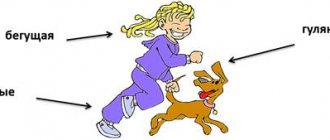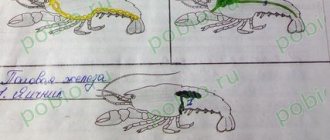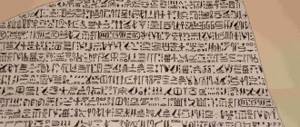Open lesson 6th grade on the topic “Alternating vowels in the root”
— What needs to be done to accurately write letters in alternating roots?Suggest a plan for our work in the lesson.
Frontal survey
– What roots with alternating vowels do you know?
– What is the peculiarity of the spelling of such roots?
– What determines the spelling of an alternating vowel at the root of a word?
"Restore the table"
Invites children to restore the deformed table: establish a correspondence between conditions and roots (in groups: blue group - from the accent, green - from the subsequent letter, yellow - from the suffix A)
Conditions for writing a vowel in roots with alternation
| Roots with alternation | |
| 1. From stress; | 1. -kas-, -kos; |
| 2. -rast-, -ros-, -rasch-; | |
| 2. From the next letter; | 3. -zar-, -zor-; |
| 4. -ber-, -bir-, etc. | |
| 3. From the presence of the suffix A after the root. | 5. -lag-, -false-; |
| 6. -gar-, -gor-; |
Checking from the board
Now your task is to talk about the roots: one student gives examples that confirm the rule, the second - exceptions to the rule, the third must summarize all the information and speak to the class, the fourth student - analyzes (corrects, supplements) the answer of the other group ( 1 the group analyzes the answer 2, 2 – 3,3-1)
Working with cards
(cards with the task for each student) (see appendix)
- Read each word carefully, highlight the root, insert the missing letters.
- Determine whether these words have the same root, remember the lexical meaning of roots with alternation.
- Find the “fourth extra” and circle the desired letter.
- Write down, insert the missing letters, underline those words to explain the spelling of which one rule can be applied: (slide)
- I parted, I die, I sunbathe, I go to heaven;
- Preheat, freeze, freeze, freeze;
- Suggestion, re.stenie, zar.sli, k.sanie.
A table appears on the interactive whiteboard.
– Look at the table, think about what unites all these spellings? What should we title it?
– What should we write down in the right window?
The teacher invites the children to open reference books that contain the same table, partially filled out in previous lessons. Students must independently fill in (or fill in the missing information) frames numbered 1, 4-12.
The teacher invites each group to create their own project based on a selected group of roots, alternating:
- Compose a linguistic fairy tale (yellow group)
- Come up with a text on the topic “I love you, my native land!”, using words with this spelling (green group)
- Write a syncwine about roots with alternation
(blue group)
General lesson “Vowels in roots with alternation”; 6th grade
A general lesson in the 6th grade is designed to arouse interest in the topic being studied, update knowledge on the topic, motivate students to formulate the topic of the lesson and the goals of their activities; create conditions for successful repetition of the studied material, a positive emotional attitude of students to work.
The lesson uses various methods: conversation, comparison, doing an exercise, working with a table, heuristic conversation, working with cards.
Silent dictation, animated presentation, and audio accompaniment are of great interest.
The material is suitable for those teachers who are looking for a non-standard approach to summarizing students’ knowledge on this topic.
Goals:
- for the teacher: to arouse interest in the topic being studied, to update knowledge on the topic, to motivate students to formulate the topic of the lesson and the goals of their activities; create conditions for successful repetition of the studied material, a positive emotional attitude of students to work;
- for students: know the conditions for choosing a spelling in roots with alternating vowels; be able to explain their spelling; select examples with the studied alternating vowels a - o, e - and in the roots of words, be able to process and structure the material, observe the basic norms of oral and written speech in the communication process, and exercise self-control.
Method of stimulating and motivating educational and cognitive activity, problem-search, practical.
Techniques: conversation, comparison, doing an exercise, working with a table, heuristic conversation, working with cards.
Forms of work: individual, frontal, independent work, test work.
During the classes:
- -Hello guys! I'm glad to see you. Today, as you can see, we have an unusual lesson. Let's determine our mood, our mood for work. (Excellent, good, not quite ready). Now let’s smile at each other and start the lesson. I hope that we will do a good job in class today. But write down the number first, great job
Slide 2
(Date, class work) Let's leave room for the topic.
Slide 3 Text on the slide:
Man has a lot to do on Earth. We need to plant a tree, train a horse to saddle, build a house, raise children. And you also need to sing a good song. And these are not all the things that a person should do. But no matter what you do: write a song or raise a child, you need to put effort into everything, give your soul to everything. (Rasul Gamzatov)
The teacher asks one of the students to read the text aloud. Students are then asked to identify the main idea of the text and explain what the author wanted to say? (How to live life.)
- – What does this text teach us? (One of the students expresses his assumption, giving arguments).
- – So today in class you and I will have to make an effort to gain knowledge and apply it in practice.
The teacher draws the children’s attention to the missing spellings in the text:
- – What are the rules for missing vowels in words? (Alternating vowels in word roots). Name the missing letters orally.
- – Try to formulate the topic of our lesson yourself. (Lesson topic appears on slide 4 )
- —Have you studied this spelling before? (Studied in 5th grade.)
- — What remains unclear to you?
-So, let's figure it out. Together we will solve this problem and learn the secrets of Russian spelling.
There are many such roots in the Russian language and they are distributed into several groups. The first group is associated with stress. Further see Appendix 1.
Slide 5 Here are the roots of gore-gar, just don’t confuse them with the words gora or grieve. Words with such roots are related to fire and lighting. And the roots of zar-zor. Let's think about when we write about, and when we write about a?
The rule goes like this: in the roots gora-gar, A is written under the accent, O is written without the accent.
Here I have prepared examples, look at the letter O. It looks like it caught fire and screams OOOOO. But in the word carbon deposits the accent is a.
With the roots zar-zor there is also an example associated with the sun. Example: zorka-zarya
The next root is very tricky, it is the clone-clan root. What's special about it?
Slide 6 Look at the words and tell me why these letters are written in them? Indeed, under the accent we will write both O and A, and without the accent only O. Let's listen to 2 lines from the famous song.
The song is playing Slide 7 +_Song
(https://xmusic.me/q/l_698rXtFaLAltiE2JKPsvKC31C23ajdpeGnxbbXi8OftW2Z5uHEuIWU8Jblp-FVpdG45-fBmOC79rn0/)
In this song, the word bowing (showing a sheet) was found with the unstressed root clone, emphasis on ya.
Slide 8 exercise
Now let's do the exercise, look at the slide. You need to think, place accents and insert missing letters.
Slide 9 Attention to the board
To correctly write words with the following roots, you need to look at what goes with what. The words are: touch, state, etc. Formulate a rule using these words. The letter a is friends with another letter a, look, she is cheerful and smiling. The letter o, on the contrary, is sad, already turning green from loneliness. Task 1 Write it down. To the board….(examples at the teacher’s discretion)
But another friendly couple, Ilya and Anechka, will help us remember the next rule. What are these roots? Words on the board. Children's answer. Tell me why we write e or i? You see, if Anya came, then Ilyusha appeared, but if she doesn’t, then the letter e comes.
Attention: What does the letter a do? the letter a works as a suffix here.
Slide 10 from the video “Silent dictation”, excised fragment from the video”
(https://www.youtube.com/watch?t=295&v=IQgiPHyjKUo) minutes 4:40
Write it down
Now let’s try to write a short “silent dictation”. What it is? I am silent, you watch a video with four actions and answer the question “what is she doing?” Write down the resulting 4 verbs.
Let's check. Well done
Slide 11 Attention to the board. other rules
The simplest rule, where almost no mistakes are made, is alternation in roots associated with growth, what kind of roots are these? growing, growing Who knows this rule? And the vowel at the root depends on the subsequent consonant, there is st or sch, which means we write a, no, we write o.
Remember, now remember the words of exception. And their derivatives have the same root.
Task 2 Write to the board...(examples of the teacher’s choice)
The next group is roots that are similar, but different in lexical meaning
The root is equal, what do you think the root –equal- means? Equal means equal in shape, size, value
Mathematical multiplication can be usefully illustrated by an excellent example.
Also, as I already said, the root -equal- denotes similarity in size.
Here is a boy and a girl, what is the same about them? That's right - growth. Compare their height, in the word the root is equal.
Remember, there are also words with the meaning of a different root, but nevertheless they are written through a-equal and plain.
Let's deal with the second root
Here is a street, and along it there are houses, how do they stand? exactly. they were aligned along the path. root equal
We are tired, but there is one more root left, this is mok and poppy. Everything is simple with them. What does maca root mean? Yes, Mac, it means to dip something into something—to dip a brush into paint. What about mok? Mok - to become wet, to absorb, to let liquid through.
Task 3 Write on the board...
- There are still many roots with alternation. You have mini-tables on your desks so that you can study this topic more fully and give your own examples.
Slide 12 table
- -Now, guys, let's see what we managed to learn during the lesson. Let's do a little independent work on the cards. You already have cards arranged according to warrants. Insert the missing letters.
- -Go ahead, you have 3-5 minutes. Time has passed.
- Who did it, you can take another card 1 or 2
Slide 13 Let's summarize Questions
Reflection, lesson summary.
- -What did we do in class? What topic did you study?
- How did we do it?
- Why do we need to know this rule, will it be useful in life?
- Is it possible to do without this topic at school?
Slide 14 Homework: learn the table, give your examples for each of the rules. Make a card for your neighbor.
Slide 15 Thank you for your attention!
See you again! Full text of the material General lesson “Vowels in roots with alternation”;
For grade 6, see the downloadable file . The page contains a fragment.
| Author: Yulia Nikolaevna Mironova → Ekaterina_Pashkova 08/17/2015 0 14055 1382 | Comment |
Thank you for your mark. If you want your name to be known to the author, log in to the site as a user and click Thank you again. Your name will appear on this page.
Login | Registration
Have an opinion? Leave a comment
Alternating unstressed vowels in the root of a word: specific examples and rules
When different word forms are formed, the sound of a word may change. This phenomenon is usually explained by the historical alternation of consonants and vowels. This feature should be taken into account in the process of identifying main morphemes or selecting test words of the same root.
Basic Rules
According to the morphological principle of the Russian language, the spelling of morphemes corresponds to how they sound if they are stressed. Roots with the alternation o-a, e-i, a-i/im, a-i/in do not obey this law. Their spelling is determined by the following conditions:
- the presence of the suffix -a-;
- consonants coming after a vowel;
- position - under stress or not;
- semantic meaning.
Let's consider cases of spelling words where there is alternation of vowels in the root: gor-gar, clone-clan, tvor-tvar, zor-zar. Without stress in the indicated morphemes it is necessary to write “o”, except for -zar-, in which the unstressed alternating vowel “a” is written. Under the accent, of course, we write the letter that we hear. Exceptions are considered: to ripen, utensils, scorch, dross.
Errors in the spelling under consideration are due to the fact that the verification method is determined incorrectly, since alternating vowels are not checked using stress. An example of a typical mistake: in the verb bend, they write the letter “ a” , choosing the same root word “bow”.
Important! It is necessary to distinguish between unstressed vowels and alternating ones. If, when performing a task, you need to find a word where there is alternation, you should remember that the difference is determined by the semantic meaning.
There is no alternation in the adjective “mountainous”, as indicated by its semantic meaning. Here the unstressed vowel is checked thanks to the stressed position: hill, hillock. Nouns: fire victim, spontaneous combustion - are similar in meaning to the verb “burn”, therefore, there is alternation here.
When the choice of writing method depends on consonants
There are morphemes in which the consonants behind it become the condition for choosing the vowels o/a. In the roots -rast-, - rasch-, - ros - “ a” before ‑ “st” or “sch” (plant growing, fusion).
In their absence, the letter “ o” is written: young shoots. Nouns: rostok, Rostov, Rostislav, moneylender, industry - these are exceptions.
The same letter is preserved in related words: Rostislavovich, Rostovites, rostok, usurious, industry worker, teenage.
Failure to apply the rule leads to the following errors:
- Sometimes, instead of a word with alternating vowels, another is written, for example, the adjective “luxurious”, without taking into account that - in this case, the syllable, and the root - luxurious - is characterized by the meaning “to grow”.
- Often they don’t see the combination “ st” , they only notice the consonant “ s” , so they can write the participle “growing up” with “ o” .
Difficulties are caused by the spelling -skak-, -skoch-, in which “ a” is used before “ k” , and the consonant “ ch” requires the spelling “o” . When applying this rule, it is important to determine which letter ( k or h ) is in the infinitive from which the word in question is derived.
Based on the fact that in the indefinite form of “gallop” a is written in the root of the word before the consonant “ k , in verbs from the phrases “I’ll gallop” on one leg or on a horse, you should choose “ a”.
Roots with alternating vowels
Words with an unstressed vowel at the root can be divided into three groups according to the method of verification:
- Words with an alternating vowel in the root. It is necessary to remember these roots, as well as the conditions for choosing vowels in them.
- Words with an unstressed vowel in the root, verified by stress, for example: sea - sea, meat - meat, mushrooms - mushroom.
- Words with unverifiable spellings that need to be checked in a dictionary and memorized, for example: dog, veteran, week.
The choice of vowel is fundamentally dependent on the consonant:
- lag - lie
- lay out - presentation, lay down - laying down
- rast (rasch) - grew
- grow up - have grown up, increment - have grown up. Exception words: Rostov, Rostislav, rostok, moneylender, but industry.
- skak - skoch
- gallop - jumped, galloped - jumped. Exception words: jump, jump.
The choice of vowel depends on the stress:
- gar - mountains (without the emphasis on, with the emphasis on a)
- tan - sunbathe, gar - burner
- zar - zor (without stress a, with stress o or a)
- dawn - dawn, lightning - dawn. Exception word: dawn.
- clan - clone (without emphasis o, with emphasis o or a)
- incline - bow, declination - bow
The choice of vowel depends on the presence of the suffix -a-:
- bira - ber
- to clean - I will remove, to collect - I will collect
- dira - der
- tear out - pull out, tear apart - tear apart
- pir - lane
- lock - lock, rest - rest
- tira - ter
- wipe - wiped, wipe - wipe
- peace - measures
- die - die, freeze - freeze
- blista - shine
- shine - shine, sparkle - shine
- stila - stela
- to lay - to spread, to re-lay - to re-lay
- zhiga - zheg (burn)
- burn out - burned out, cauterize - cauterize
- chita - even
- subtract - subtract, count - counting
- kasa - kosn
- touch - touch, tangent - touch
The choice of vowel depends on the meaning of the word:
- equal - equal
- equal → in words meaning “equal”, “identical” equation, equal, equal
- level → in words meaning “even”, “straight”, “smooth” to level, level, level out
- poppy - mok
- poppy → in words meaning “immerse in liquid”, dip bread in honey, dip a brush in paint
- get wet → in words meaning “to let liquid through”, get wet in the rain, soak clothes
Note.
Roots with alternation also include the roots cha - chin, mya - min, zha - press, nya - nim, klya - wedge. The letter and is written in them if there is a suffix -a- after the root.
begin - begin, crush - crush, press - squeeze, accept - borrow, spell - curse
Note.
In the roots plav - pilaf it is always written plav: melt, swim, float, smelting.
The root pilaf is written in exception words: swimmer, swimmer, swimmers.
Note.
In the roots of creature - creation, creation is always written: create, creator, creation.
The root creature is written in exception words: creature and utensils.
Source: https://www.rusyaz-online.ru/pravila/korni-s-cheredovanijem




